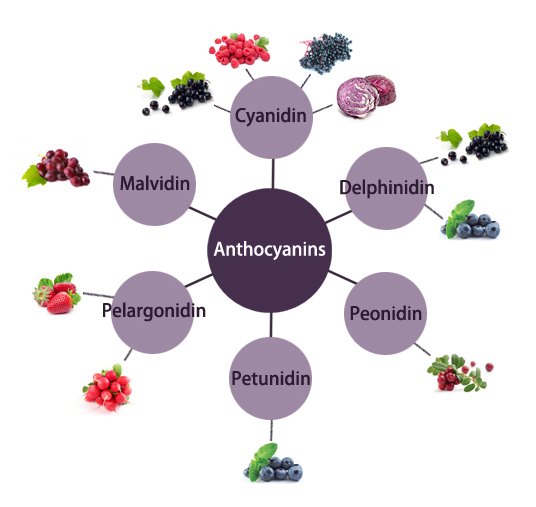Introduction and Efficacy of Anthocyanins
2020-08-21
 Anthocyanins (anthocyanosides) are a kind of water-soluble pigments widely existing in plants, belonging to flavonoids. There are six common pigments in plants, namely pelargonidin (PG), cyanidin (CY), delphinidin (DP), peony pigment (PN), Petunia pigment (PT) and Mallow pigment (MV). Under natural conditions, anthocyanins are very rare. They often form anthocyanins through glycosidic bonds with one or more glucose, rhamnose, galactose, xylose, arabinose, etc. the glycosides and hydroxyl groups in anthocyanins can form acylated anthocyanins through ester bonds with one or more aromatic acids and fatty acids such as coumaric acid, ferulic acid, caffeic acid and p-hydroxybenzoic acid. More than 250 kinds of anthocyanins are known to exist naturally in plants of 73 genera and 27 families.
Anthocyanins (anthocyanosides) are a kind of water-soluble pigments widely existing in plants, belonging to flavonoids. There are six common pigments in plants, namely pelargonidin (PG), cyanidin (CY), delphinidin (DP), peony pigment (PN), Petunia pigment (PT) and Mallow pigment (MV). Under natural conditions, anthocyanins are very rare. They often form anthocyanins through glycosidic bonds with one or more glucose, rhamnose, galactose, xylose, arabinose, etc. the glycosides and hydroxyl groups in anthocyanins can form acylated anthocyanins through ester bonds with one or more aromatic acids and fatty acids such as coumaric acid, ferulic acid, caffeic acid and p-hydroxybenzoic acid. More than 250 kinds of anthocyanins are known to exist naturally in plants of 73 genera and 27 families.
Anthocyanins (anthocyanosides) is a natural anti-aging nutritional supplement, which has been proved to be the most effective antioxidant found by human beings. The antioxidant activity of anthocyanins is 50 times higher than that of vitamin E and 20 times higher than that of vitamin C. It is 100% bioavailable to the human body and can be detected in the blood 20 minutes after taking it. Unlike other antioxidants, anthocyanins directly protect the brain and nervous system through the blood-brain barrier.
Effect of anthocyanins:
1. It helps to prevent a variety of free radical related diseases, including cancer, heart disease, premature aging and arthritis;
2. Reduce the incidence of heart disease and stroke by preventing platelet aggregation caused by stress and smoking;
3. Strengthen the immune system to resist carcinogens;
4. Reduce the frequency and duration of cold;
5. It has the function of anti mutation to reduce the formation of carcinogenic factors;
6. It has anti-inflammatory effect, so it can prevent inflammation including arthritis and swelling;
7. Alleviate pollinosis and other allergies;
8. The elasticity of arteries, veins and capillaries was enhanced;
9. Protect the inner wall of artery;
10. Maintain the normal flexibility of blood cells to help red blood cells pass through small capillaries;
11. Relax blood vessels to promote blood flow and prevent hypertension (blood pressure lowering effect);
12. Prevent the rise of blood pressure caused by angiotensin-converting enzyme released from the kidney (another blood pressure lowering effect);
13. As a barrier to protect brain cells, it can prevent the formation of amyloid beta protein, the toxicity of glutamate and the attack of free radicals, so as to prevent Alzheimer's disease;
14. Through the inhibition of elastase and collagenase, the skin becomes smooth and elastic, and prevents skin damage caused by excessive sunlight from inside and outside.
15. Anthocyanins also have anti radiation effect. The color of anthocyanins will change due to different pH values. Most anthocyanins have good stability of light, heat and pH value. For white-collar workers or people who have been exposed to the sun and electric radiation for a long time, the efficacy of anthocyanins is indispensable.
16. Anthocyanins can promote the regeneration of rhodopsin in retinal cells, prevent myopia and improve vision.
Prev :None
Next :None

